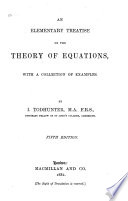 | Charles Davies - Algebra - 1871 - 404 pages
...VARIATIONS of signs, nor the number cf negative roots gj eater than the number of PERMANENCES. Consequence. For, let m denote the degree of the equation, n the...variations of the signs, p the number of permanences ; then, m = n + p. Moreover, let n' denote the number of positive roots, and p' the number of negative... | |
 | Elias Loomis - Algebra - 1873 - 396 pages
...there must be as many permanences as there are negative roots. If all the roots of an equation are real, the number of positive roots is equal to the...number of variations, and the number of negative roots is equal to the number of permanences. If the equation is incomplete, we must supply the place of any... | |
 | Joseph Ficklin - Algebra - 1874 - 446 pages
...one real negative root. Сок. 2. — If the equation f(x) = 0 is complete, and all its roots are real, the number of positive roots is equal to the number of variations in the signs of its terms, and the number of negative roots is equal to the number of permanences in... | |
 | Webster Wells - Algebra - 1880 - 498 pages
...number of terms less one, or is equal to the degree of the equation (Art. 480). Hence, when the roots are all real, the number of positive roots is equal...number of variations, and the number of negative roots is equal to the number of permanences (Art. 487). A complete equation whose terms are all positive... | |
 | George Shoobridge Carr - Mathematics - 1880
...changes of sign, or more negative roots than continuations of sign. 419 When all the roots of f(x) are real, the number of positive roots is equal to the number of changes of sign in /(ж) ; and the number of negative roots is equal to the number of changes of sign... | |
 | Isaac Todhunter - Equations, Theory of - 1880 - 360 pages
...number of changes of sign must have been introduced. 68. When all the roots of an equation f (x) = 0 are real, the number of positive roots is equal to the number of changes of sign in f (x), and the number of negative roots is equal to the number of claanges of sign... | |
 | William Snow Burnside, Arthur William Panton - Determinants - 1881 - 407 pages
...as the number of variations of sign in/(- #). 7. "When an equation is complete; if all its roots are real, the number of positive roots is equal to the...number of variations, and the number of negative roots is equal to the number of continuations of sign. 8. An equation having an even number of variations... | |
 | Elias Loomis - Algebra - 1881 - 398 pages
...must be as many permanences as there are negative roots. If all the roots of an equation are reaI, the number of positive roots is equal to the number of variations, and the number of negative roots is equal to the number of permanences. If the equation is incomplete, we must supply the place of any... | |
 | Isaac Todhunter - Equations - 1882 - 348 pages
...number of changes of sign must hare been introduced. 68. When all the roots of an equation f (x) = 0 are real, the number of positive roots is equal to the number of changes of sign in f (x), and the number of negative roots is equal to the number of changes of sign... | |
 | William Snow Burnside, Arthur William Panton - Determinants - 1886 - 478 pages
...the number of variations of sign in /(— x). 7. When an equation is complete ; if all its roots are real, the number of positive roots is equal to the...number of variations, and the number of negative roots is equal to the number of continuations of sign. 8. An equation having an even number of variations... | |
| |